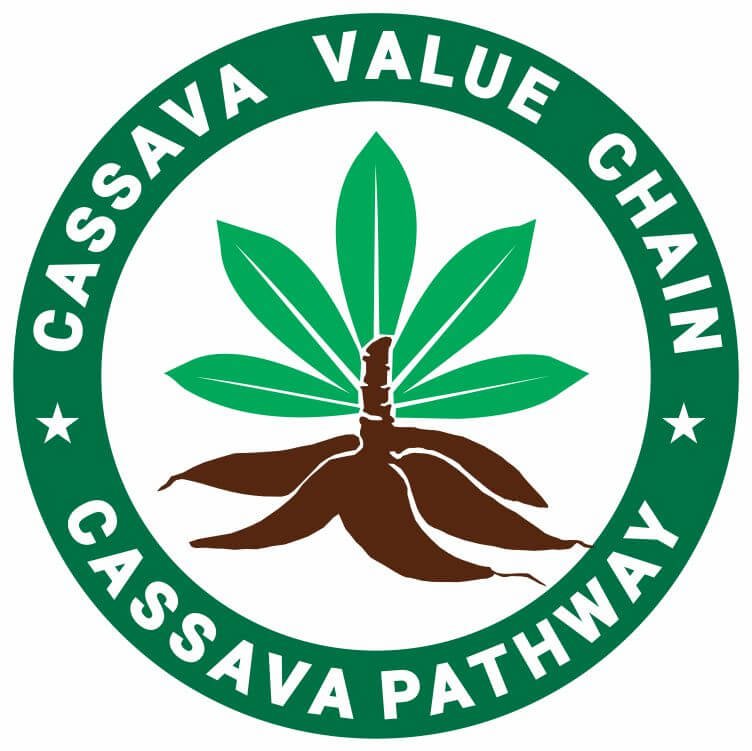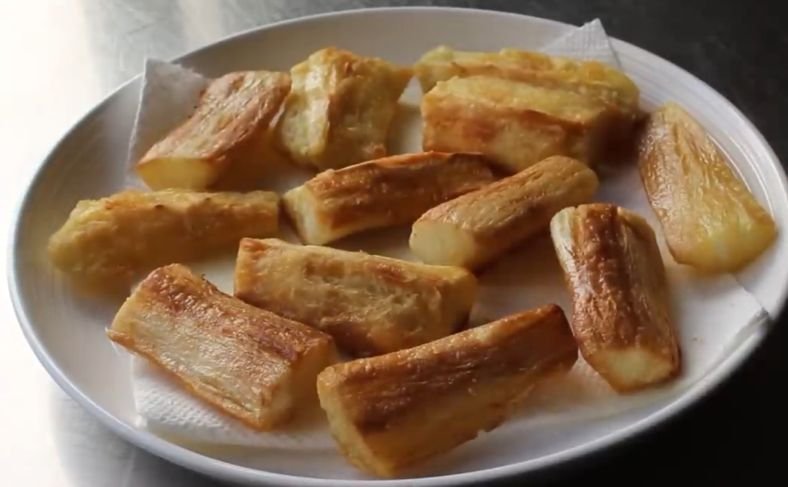Yuca fries, cassava fries, or yuca frita, whatever you call them, these crispy roots are a must-try. Learn what makes them special and how to cook them perfectly.
Craving something crispy, golden, and just a little different from your usual fries?
Yuca fries, also called cassava fries or yuca frita, might be exactly what you didn’t know you were missing.
Made from the starchy yuca root, these thick-cut fries have been making their way from street food stalls and traditional kitchens into modern plates, bringing along a deep, earthy flavor and satisfying crunch.
Whether you’ve spotted them at a Latin American restaurant or stumbled across frozen yuca in your local market, chances are you’ve wondered what exactly goes into making them.
They’re not just a trend, they’re a staple rooted in generations of cooking traditions. And the best part?
They’re easier to make at home than you might expect. In this post, we’ll break down how to prepare yuca fries from start to crispy finish—and enjoy them your way.
Recommended: The Making of Manioc Tortillas
Table of Contents
- What are Yuca or Cassava Fries?
- Yuca Frita, Cassava Fries, Yuca Fries: Why the Many Names?
- What Does Yuca Frita Taste Like?
- Health Benefits and Cassava Fries Nutrition
- Types of Yuca Fries (Yuca Frita)
- How to Make Yuca Fries/Cassava Fries Recipe
- Best Dipping Sauces for Yuca Fries
- Yuca Frita for Special Diets
- Are There Risks to Eating Yuca Fries?
- Can I Make Yuca Fries Without Boiling?
- What Is the Best Oil for Frying Yuca?
- Can You Freeze Cooked Yuca Fries?
- Yuca Fries Around the World
- Yuca Fries vs French Fries
- Frequently Asked Questions
- Final Words
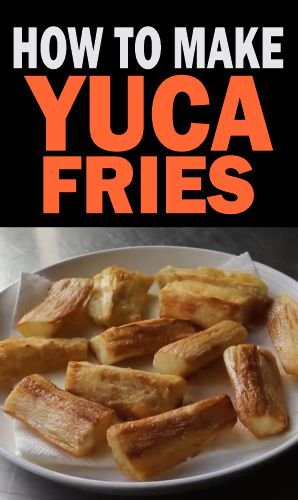
What are Yuca or Cassava Fries?
Yuca fries are thick, hearty strips cut from the yuca root. With a naturally dense texture and mildly earthy flavor, they offer a satisfying alternative to traditional potato fries.
Their golden, crispy exterior and soft, creamy interior make them a favorite comfort food across cultures.
It is important not to confuse yuca fries with cassava sticks and cassava chips, as they are different.
Often served as a snack or side dish, yuca fries are celebrated for their ability to hold up well to bold seasonings and savory sauces.
Yuca Frita, Cassava Fries, Yuca Fries: Why the Many Names?
Yuca frita, cassava fries, and yuca fries all refer to the same delicious dish, fried slices or chunks of the starchy cassava root.
The difference in names comes from language and regional preference.
“Yuca frita” is the Spanish term, common in Latin American countries like Cuba and the Dominican Republic.
“Cassava fries” is the English equivalent, often used in health and culinary circles.
“Yuca fries” is a blend of both, popular in the U.S. and online searches.
Despite the name, the dish stays the same: golden, crispy outside with a soft, fluffy center.
Whether served with garlic mojo, spicy dip, or plain, these fries are a global favorite with local flair. Just different names for the same tasty root.
Related: How to Make Tapioca Chips
What Does Yuca Frita Taste Like?
You’re probably wondering what to expect when you take that first bite of yuca fries.
Here’s a straight-up answer with no fluff, just real flavor, texture, and why they have a fanbase.
Description of Flavor and Texture
Cassava fries have a clean, earthy flavor with a subtle nutty note. The inside is tender like mashed potatoes but slightly firmer and drier.
On the outside, you get that golden crisp that crunches nicely when done right.
Unlike potato fries that sometimes taste bland, yuca holds its flavor better and carries dips beautifully.
It doesn’t turn soggy quickly either, which gives it an edge on texture and satisfaction.
Why People Love Them
You love yuca frita for more than just the taste. They’re naturally gluten-free and filling, which makes them perfect if you’re avoiding wheat.
They soak up spices and seasonings in a way that makes each batch feel customized.
Plus, they look rustic and real on your plate. If you’re bored with the same old fries, yuca gives your cravings something new without straying too far from comfort.
Best Cooking Methods for Taste Retention
To keep that rich texture and deep flavor, start by boiling your yuca chunks until tender but not mushy.
This softens the inside so they don’t dry out during frying. After draining, fry them in hot oil until the outside forms a crispy shell.
You can also air-fry or bake them with a light oil coating for a cleaner option.
Avoid overcrowding so they cook evenly and stay crunchy.
Related Posts
How to Make Homemade Dipping Sauces for Yuca Fries
Cassava Root in the Caribbean Cuisine
How to Use Tapioca Starch as a Thickener
Step-by-step Guide to Make Tapioca Pearls
Yuca-based Foods Around the World
Health Benefits and Cassava Fries Nutrition
A 1-cup serving of yuca frita (140g) contains around 376 to 377 calories, mostly from carbohydrates and fat.
It delivers 19.5g of total fat, mainly from frying oil, and 48.6g of carbs, including 2.2g of fiber and 2.2g of natural sugars. Baking or air-frying helps cut down on fat.
Protein content is low at 1.7g, so pair yuca fries with a protein-rich dish.
Nutritionally, they provide 21mg of vitamin C, 346mg of potassium, and trace amounts of calcium, magnesium, iron, and B6.
As a naturally gluten-free food, cassava fries are also a good source of resistant starch that supports gut health, digestion, and blood sugar control.
When not deep-fried, they retain more nutrients, making them a satisfying and healthier alternative to regular fries.
See full health benefits and nutrition facts for yuca fries.
Types of Yuca Fries (Yuca Frita)
Yuca frita comes in different cuts and cooking styles, each offering a unique texture and flavor.
From thick chunks to crispy thin sticks, and from deep-fried to air-fried, there’s a type of yuca fry for every craving.
Thick Cut vs Thin Cut Yuca Fries
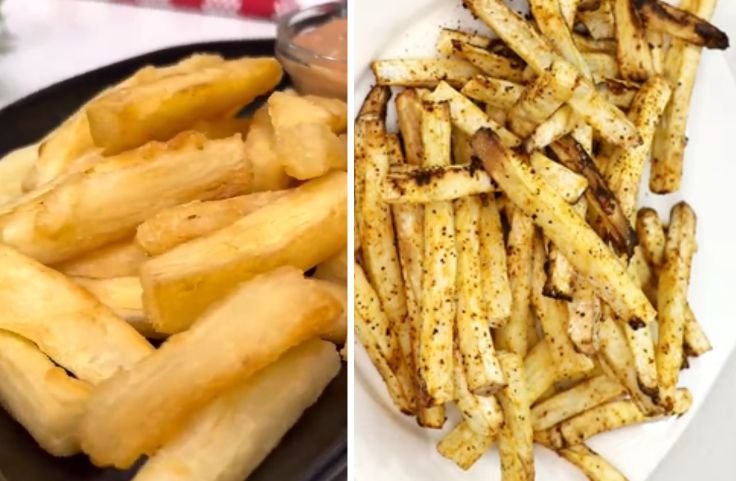
Thick-cut yuca frita is chunky and satisfying with a soft center and crisp edges. They’re perfect for bold dips and hearty appetites.
Thin-cut fries cook faster, are crispier, and feel snackable. Each offers a different experience, thick for richness, thin for crunch, so your choice depends on whether you prefer creamy bites or crispy textures.
Boiled and Fried vs Twice-Fried (Cuban Style)
Boiled and fried yuca is the classic style, soft inside, golden outside, and simple to make.
The Cuban-style twice-fried method goes further: boil, fry, cool, then fry again for maximum crunch.
This double fry creates a crispier texture with a creamy center, ideal with mojo sauce. It’s a bit more work, but worth it for crispy lovers.
Frozen Packaged Yuca Fries
Frozen cassava fries save time and effort by skipping peeling and slicing. They’re par-cooked, ready to pop into your oven, air fryer, or skillet.
While the texture may differ slightly from fresh yuca, they still deliver a satisfying crunch.
These fries are great for quick meals, busy nights, or when you want yuca without the prep work.
Air-Fried Yuca Fries
Air-fried yuca frita is a healthier take with less oil and full crunch. Boil the yuca first, then air-fry for a golden, crispy shell and soft inside.
This method suits gluten-free and vegan diets, and cleanup is easy.
Season as you like and enjoy a snack that satisfies without a deep-fry mess. Great for guilt-free indulgence anytime. More on Air fryer yuca fries.
Baked Cassava Fries
Baked cassava fries are a healthier alternative to the traditional deep-fried version.
Made from peeled, boiled cassava roots, they are cut into fry-like shapes and baked in the oven with a light coating of oil.
This method reduces overall fat content while still giving you a crispy outside and a soft, starchy center.
You can season them with salt, garlic, paprika, or herbs for extra flavor.
Baked cassava fries are naturally gluten-free and make a great side dish or snack.
They’re especially popular among those who prefer clean eating or want to avoid deep-frying at home. See how to bake cassava fries.
Related: How to Make Traditional Cassava Pancake
How to Make Yuca Fries/Cassava Fries Recipe
To make yuca frita, you’ll need just a few simple ingredients and a little patience to prep the root properly.
Follow the steps below to get perfectly cooked, flavorful cassava fries right from your kitchen.
Ingredients:
- 2 large yuca roots
- 4 cups of water
- 1 tablespoon of salt
- 3 cups of vegetable oil (for frying)
- 1 teaspoon of garlic powder (optional)
- 1 teaspoon of paprika (optional)
- Fresh parsley for garnish (optional)
- Salt to taste
Instructions:
Select and Peel the Yuca Root
Choose firm yuca roots with no soft spots or mold. Cut off both ends and slice the root into manageable sections.
Use a sharp knife to cut into the tough brown skin and peel away both the outer layer and the pinkish-white inner layer.
Rinse the peeled sections under water to remove any dirt or residue before cutting.
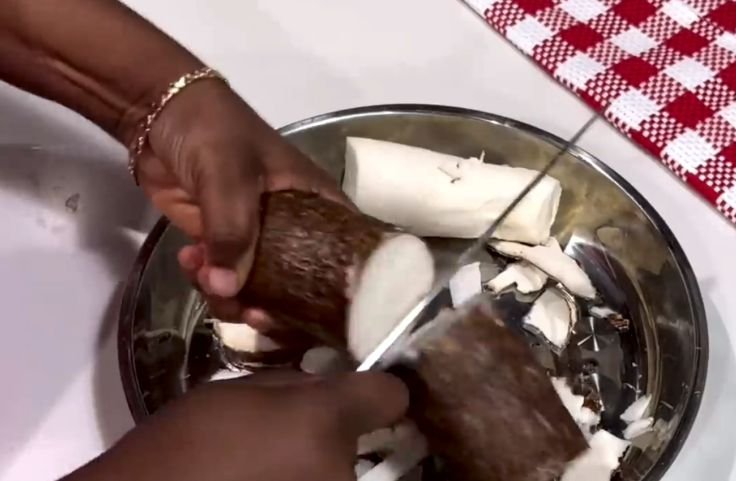
Slice into Uniform Fry Shapes
After peeling, slice each section of yuca in half lengthwise. Remove the woody core that runs through the center; it’s tough and not pleasant to eat.
Then cut the yuca into thick, even fry shapes, about the size of steak fries.
Uniform pieces ensure they cook evenly and develop that perfect crispy texture during frying or baking.
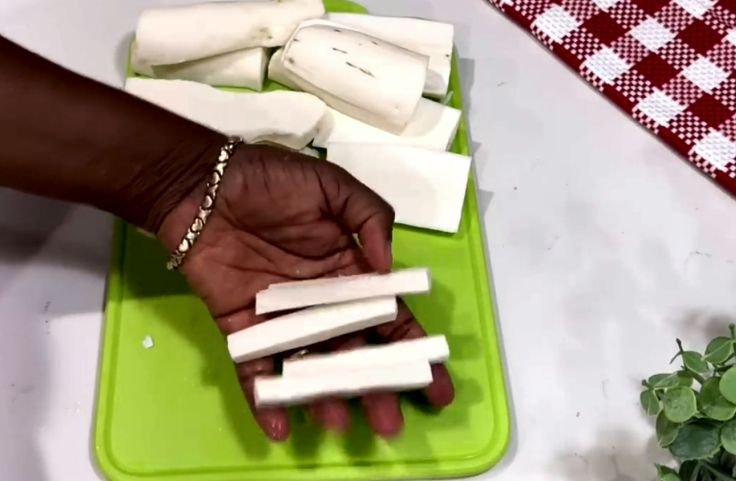
Boil the Yuca Before Frying
Place the cut yuca into a large pot and cover with water. Add a tablespoon of salt and bring to a boil over medium heat.
Let the yuca cook for about 10 to 12 minutes, just until it becomes fork-tender.
Do not overcook, it should be soft inside but still hold its shape. Drain and let cool completely.
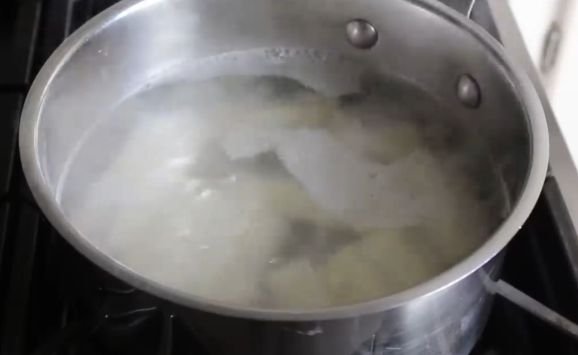
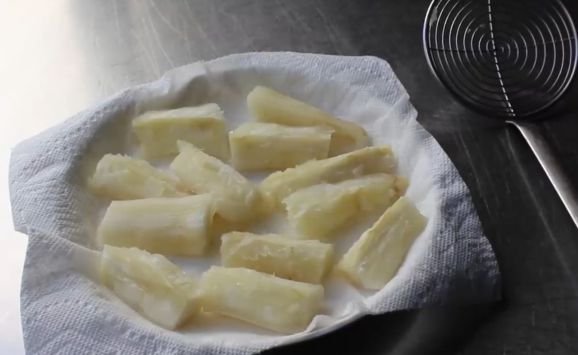
Fry the Yuca Until Crispy
Heat vegetable oil in a deep skillet or fryer to 375°F (190°C). Carefully place the cooled yuca sticks into the hot oil in small batches.
Fry for 3 to 5 minutes, or until golden brown and crispy on the outside.
Use a slotted spoon to remove the fries and place them on paper towels to drain.
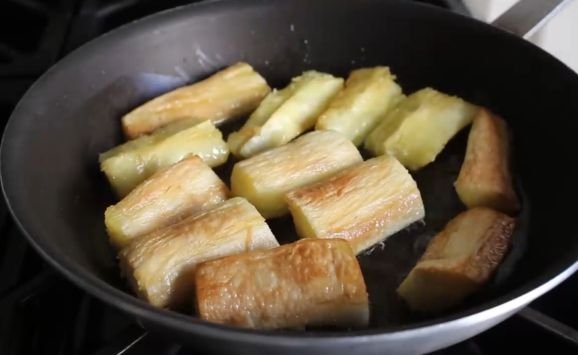
Season and Garnish While Hot
While the fries are still hot, sprinkle them with salt to taste. For extra flavor, add garlic powder, paprika, or a pinch of chili powder.
Fresh parsley makes a great garnish. Seasoning while hot allows the flavors to stick better and enhances the taste of the fries without overpowering the natural flavor of yuca.
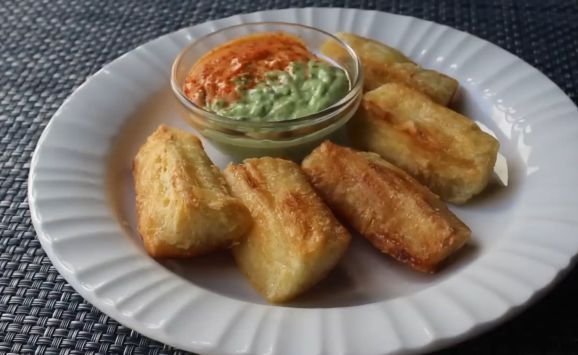
Best Dipping Sauces for Yuca Fries
Yuca frita is satisfying on its own, but dipping sauces take it to another level.
Whether you like creamy, tangy, or spicy flavors, the right dip adds contrast and depth. Here are some of the best sauces to try.
Garlic Aioli
Garlic aioli gives your yuca fries a creamy, bold finish. The mayo base softens the garlic bite, making each dip smooth and flavorful.
It pairs perfectly with the starchy texture of yuca, adding richness without overpowering the taste.
Add a bit of lemon juice or herbs to bring freshness and balance to every bite. See a dedicated post on cassava fries dipping sauces.
Mojo Sauce (Cuban Style)
Mojo sauce brings brightness and heat. Made with garlic, sour orange juice, and olive oil, this Cuban dip cuts through the dense texture of yuca frita with a citrusy punch. It’s light, tangy, and full of character.
You’ll love how it wakes up your taste buds and adds a zesty layer to every fry.
Ketchup, Sriracha Mayo, or Chimichurri
Sometimes, the classics just work. Ketchup keeps it simple and familiar. Sriracha mayo adds creamy heat, great if you like a little kick.
Chimichurri is herby and sharp, full of parsley, vinegar, and garlic.
Each of these options gives you a different experience, so try one or all three to match your mood and spice level.
Yuca Frita for Special Diets
Trying to enjoy fries while sticking to your diet plan? Yuca fries give you a satisfying option that works with a range of special diets.
Here’s how they fit into gluten-free, paleo, vegan, and vegetarian lifestyles without making you feel restricted or bored.
Gluten-Free Diets
If you’re cutting out gluten, yuca frita is one less thing to worry about.
The yuca root is naturally gluten-free, making it a safe starch for those with celiac or gluten sensitivity.
Just make sure you avoid any flour-based coatings or shared fryers that may cause cross-contamination.
Bake them at home or air fry in clean oil for better control.
They’re dense, filling, and perfect when you need a carb fix that doesn’t involve wheat, barley, or rye.
Top them with gluten-free sauces to keep everything on track.
Paleo and Whole30
Yuca fries can fit into your paleo or Whole30 eating plan if you keep the ingredients clean.
Since the yuca root comes straight from the ground with no processing, it checks the box for whole foods. More on cassava as paleo here.
Avoid frying in seed oils and skip sauces that contain sugar or dairy.
Instead, bake or roast them in coconut or olive oil and season with sea salt, garlic, or herbs.
These fries give you the satisfaction of comfort food while still sticking to the no-grains, no-legumes, no-dairy rules of your plan. See cassava paleo recipes.
Vegan and Vegetarian Approaches
If you’re vegan or vegetarian, yuca fries are an easy and flavorful side that doesn’t rely on animal products.
The root itself is 100 percent plant-based, and you control what goes into it.
Cook with avocado, olive, or sunflower oil and season with fresh herbs, paprika, or garlic powder.
Pair them with vegan dips like cashew cheese sauce, tahini, or dairy-free garlic aioli for extra flavor.
Whether it’s a weeknight meal or a snack, yuca fries fit perfectly into a plant-based lifestyle without leaving you hungry.
Are There Risks to Eating Yuca Fries?
Yuca fries taste great and come with health benefits, but it’s smart to know what could go wrong if they’re not handled properly.
Here’s what you need to keep in mind before cooking or eating them.
Cyanide Content in Raw Yuca
Raw yuca contains compounds called cyanogenic glycosides, which can release cyanide when eaten uncooked or poorly prepared.
That sounds scary, but it’s only a real concern with raw or bitter yuca.
The sweet variety used in most cooking is lower in these compounds. Still, you shouldn’t eat yuca raw or undercooked.
When you boil, soak, or cook it thoroughly, these harmful compounds break down and flush away.
The key is making sure the root is peeled, rinsed, and well-cooked before you turn it into fries.
Proper Preparation to Remove Toxins
You don’t have to avoid yuca, just treat it the right way. Always peel the skin completely, cut it into chunks, and boil it until tender before moving to frying, baking, or air frying.
Boiling helps remove any remaining toxins that could linger in the raw root. Never skip this step, even if you’re short on time.
Don’t fry yuca straight from the raw, as it may still contain traces of cyanide.
Proper preparation makes yuca not only safe but also more enjoyable in taste and texture. See how to remove toxins from cassava.
Safe Consumption Practices
Eating yuca fries is safe when they’re made the right way. Stick to sweet yuca, boil it first, and don’t eat it raw or undercooked.
If you’re buying frozen yuca fries, check the label to make sure they’ve been pre-cooked.
When frying at home, always start with boiled yuca. Avoid eating large amounts daily; treat them like any other starchy food.
A moderate serving as a snack or side dish won’t harm you when properly prepared. Stick to smart kitchen habits and you’re good to go.
Can I Make Yuca Fries Without Boiling?
You can technically fry raw yuca, but it’s not safe or ideal. Raw yuca contains cyanogenic compounds that can release cyanide if not properly cooked.
Boiling breaks down these toxins, making the root safe to eat. Skipping this step may also leave the inside undercooked and tough while the outside crisps too quickly.
Boiling softens the center, helping it fry evenly and absorb seasoning better.
If you want fries that are both safe and delicious, always boil the peeled yucca first.
After boiling, let it cool before frying to get the best texture and flavor.
What Is the Best Oil for Frying Yuca?
The best oil for frying yuca should have a high smoke point and a neutral taste.
Peanut oil, avocado oil, sunflower oil, and refined coconut oil are solid choices.
These oils handle high heat well and won’t overpower the flavor of the yuca. If you prefer a slightly nutty undertone, go for peanut oil.
For a cleaner and more health-conscious option, avocado oil is a favorite.
Avoid oils like extra virgin olive oil or butter, which burn easily and affect taste.
Stick to neutral, stable oils for crispy fries that taste as good as they look.
Can You Freeze Cooked Yuca Fries?
Yes, freezing cooked yuca fries is a great way to save time and prevent waste.
After frying, let the fries cool completely, then spread them on a baking tray to freeze individually.
Once solid, transfer them to an airtight bag or container. This prevents them from clumping together.
To reheat, use an oven or air fryer, never a microwave, which makes them soggy.
Frozen yuca fries keep their texture well when reheated properly.
They’re perfect for quick snacks or meal prep. Just make sure they were fully cooked before freezing to keep them safe and tasty later.
Yuca Fries Around the World
Cassava fries show up in kitchens and street food stalls all across the globe. They may look simple, but every region puts its spin on them.
Here’s how yuca fries are made and enjoyed in different parts of the world.
Latin America: Cuba, Venezuela, Brazil
In Latin America, yuca fries are more than just a snack; they’re part of the culture.
In Cuba, they’re often boiled first, then fried and served with mojo sauce made from garlic and citrus.
In Venezuela, you’ll find them next to fried cheese or meat, especially during family gatherings.
Brazil takes a bold approach by seasoning them with garlic and parsley, sometimes serving them with spicy dips or creamy sauces.
They’re hearty, comforting, and always tied to a social table. Every country adds a twist that reflects its flavor preferences.
African and Caribbean Versions
In West Africa and parts of the Caribbean, yuca is a staple, and the fries are a familiar sight at homes and roadside stalls.
In Nigeria or Ghana, they’re usually fried until golden and served with pepper sauce or fried fish.
Caribbean islands like the Dominican Republic or Jamaica also include them in meals with jerk chicken, spicy stews, or pickled onions.
The preparation is simple but deeply rooted in tradition, with bold spices and homemade dips bringing the fries to life.
Restaurant Styles vs Home-Cooked
When you eat cassava fries at restaurants, especially upscale or fusion spots, they’re usually extra crispy, served with gourmet sauces, and neatly plated.
Chefs may add truffle oil, fancy dips, or even sprinkle herbs for a visual and flavor boost.
At home, the approach is more relaxed: boil, fry, season, and eat while hot. You control the oil, seasoning, and portion.
The homemade version feels more rustic and satisfying, especially when shared fresh from the pan.
Both styles have their charm, but the flavor always shines through.
Yuca Fries vs French Fries
Yuca fries and French fries share a similar look but offer distinct differences in taste, texture, and nutrition.
Made from cassava root, yuca fries are denser, crunchier, and carry a mild, earthy flavor with a hint of sweetness.
French fries are lighter with a crisp outer layer and soft center, often seasoned to boost flavor.
In terms of nutrition, yuca is higher in carbs and fiber, packed with vitamin C, and naturally gluten-free, ideal for those with specific dietary needs.
French fries deliver potassium and vitamin B6, but are often higher in fat and calories due to deep-frying.
Yuca holds cultural significance in Latin American and African cuisine, while French fries dominate Western diets and fast food menus.
Want a full breakdown of flavor, texture, and health comparisons?
Read the full Yuca Fries vs French Fries guide here.
Frequently Asked Questions
What are yuca fries made from?
Yuca or cassava fries are made from yuca (cassava), a starchy root vegetable that is peeled, sliced into strips, and either fried or baked.
Is yuca healthier than French fries?
Yuca is often healthier than French fries due to its lower fat content when baked and its higher fiber and vitamin content.
How do you prepare yuca to eat?
Peel and slice yuca into strips, then boil until tender, and either fry or bake until crispy, seasoning as desired.
Final Words
Yuca fries, also called cassava fries, offer a unique and healthier alternative to traditional French fries.
Made from the starchy yuca root, they can be prepared by frying or baking to achieve a crispy texture.
With their nutty flavor and dense texture, cassava fries not only satisfy cravings but also provide various nutritional benefits, including fiber and vitamins.
Whether you choose to bake or fry, cassava fries can be a delicious addition to your diet, offering a tasty twist on a classic favorite.
References:

Chimeremeze Emeh is a writer and researcher passionate about Africa’s most transformative root crop—cassava. Through his work at cassavavaluechain.com, he explores the entire cassava industry, from cultivation and processing to its diverse applications in food, health, and industrial use.
He also writes for palmoilpalm.com, where he shares his extensive experience and deep-rooted knowledge of palm oil, covering red palm oil, palm kernel oil, and refined products. His work there reflects his lifelong connection to agriculture and his commitment to promoting sustainable value chains in Africa.
Driven by curiosity and purpose, Chimeremeze aims to shed light on how cassava continues to empower communities, strengthen food systems, and link traditional farming wisdom with modern innovation.
